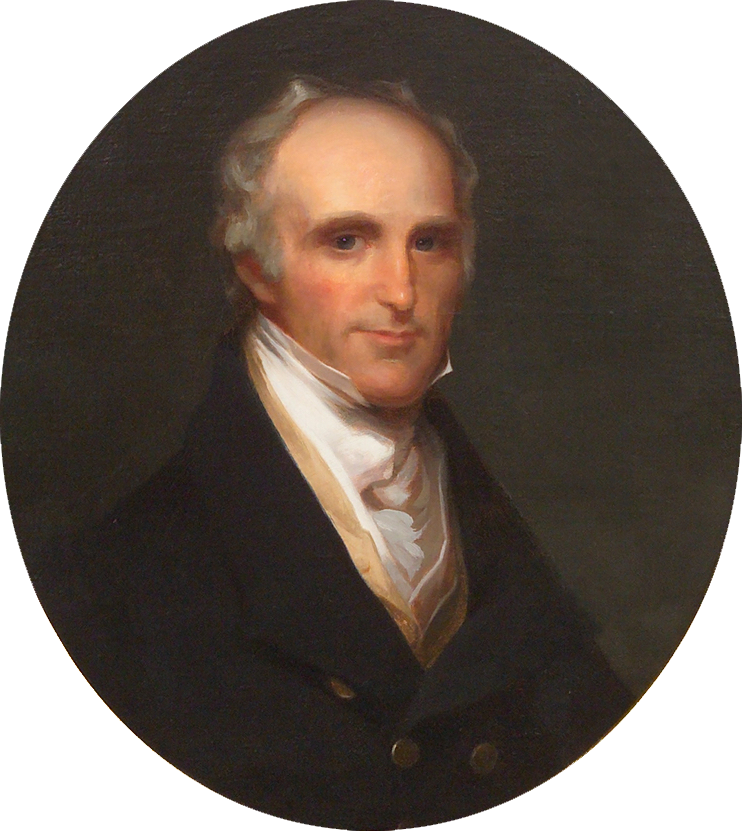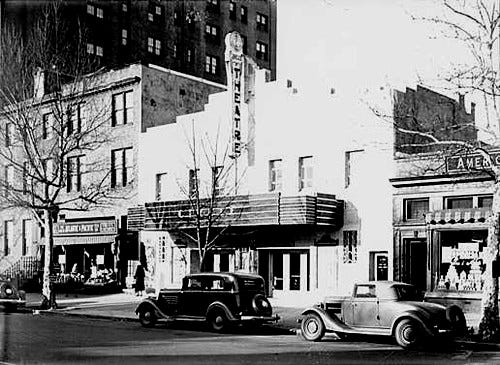The History of Washington's "Six Buildings"
Once Home to the Navy and State Departments, as well as the Circle Theatre
Equally as important as the “Seven Buildings” in the history of early Washington, DC was another row of buildings that also stood west of the White House on Pennsylvania Avenue and were known as the “Six Buildings.” Built in 1797, one of these buildings remained standing until 1985.
In 1794, Massachusetts real estate investor James Greenleaf, with the help of a letter of recommendation from George Washington, bought 3,000 lots from the District Commissioners at a bargain price of $66.50 each, committing to build 70 houses at a rate of twenty a year to be ready in time to house members of Congress when they arrived in the city in 1800.
In 1795, Greenleaf started construction of the “Six Buildings” on the 2100 block of Pennsylvania Avenue, NW as part of his purchase agreement with the Commissioners. In addition, he also formed a syndicate with Robert Morris and John Nicholson to sell some of the other 3000 lots he bought from the Commissioners. They then sold 500 of those lots to Thomas Law at four times what Greenleaf had originally paid. This infuriated Washington who thought the Commissioners should have been able to get a much higher price than they did.
Greenleaf eventually found himself heavily in debt. Land sales were not occurring fast enough, nor at prices high enough to allow him to meet his mortgage payments to the Dutch banks who had financed his lot purchases. Morris and Nichols ended up buying Greenleaf out of his share of the syndicate. But they too were in over their heads financially and couldn't live up to all the purchase contracts with the Commissioners, leaving unfinished houses throughout city, including the Six Buildings. All three would eventually end up in debtor's prison.
Morris and Nichols sold the unfinished Six Buildings to Isaac Polock for $34,000 (the equivalent of over $857,000 in 2025) with the condition that he complete them to meet the requirements of at least one of their contracts with the Commissioners.
Polock, the first documented Jewish resident of Washington, had only just arrived in town from Newport, Rhode Island, where he had made a fortune in real estate. Upon his arrival in Washington, he immediately began buying up lots. The prospect of six lots with partially completed houses on them, and with the new government due soon in town in need of housing, must have made Morris and Nicholson’s high asking price seem worth the risk.
Numbering 2107 to 2117 Pennsylvania Avenue, the six, three-story, 3 bay, brick buildings with single dormers and deep English basements were completed and occupied by the end 1797. A seventh house, very similar to the other six, was added on the east end of the row in 1800 by William Worthington, whose family then occupied the house for over 50 years
Polock took the western-most house at 2117 Pennsylvania Avenue for himself and lived there until his death. He was succeeded in the house by Richard Rush, a friend of John Adams, who lived there while serving as the United States Attorney General between 1814 to 1817.
The Six Buildings were among the few at the time that were near enough to the White House that, while designed as residences, were large enough and could be quickly converted for use as government offices. Due to overcrowding in the Treasury Building, they became the temporary home to the Navy Department, and for a short time to the Department of State. The Navy Department occupied the building at 2107 Pennsylvania Avenue, which also served also as a pied-à-terre for Navy Secretary Benjamin Stoddert.
It is unknown which of the Six Buildings the State Department actually occupied. Although Richard Rush offered the Madisons his own house, the historian Allen C. Clark in Life and Letters of Dolly Madison (published 1914) claimed that the Madisons likely lived at 2113 Pennsylvania Avenue. This house may have served as their private residence with the State Department in another building, or they simply had rooms in the office building itself. Nevertheless, the State Department would soon move to the large corner house of the Seven Buildings at 1901 Pennsylvania Avenue.
Narsworthy Hunter, Delegate of the Mississippi Territory, who was the first member of Congress to die while in office, lived in and died in one the Six Buildings in March 1802. His funeral was the first publicly-funded funeral for a congressmen, and the members of both houses of Congress, their officers, and heads of departments, all walked in the funeral procession that started from his residence at the Six Buildings.
Samuel “Sam” Houston resided at 2107 Pennsylvania Avenue, probably while he was in Congress from 1823 to 1827, and living in the same house the Navy Department had previously occupied. Some other prominent residents of the Six Buildings were General James Wilkinson, General and Chief of the Army in 1796, John Francis Mercer, the first president of the Chesapeake & Ohio Canal Co., and William Seward, possibly when he was serving as a Senator from New York.
By the later part of the 19th century, the Six Buildings were no longer the high-end residences they once were. Victims of the spread of commercialism along the city’s major corridors, over time they gradually became a mix of storefronts, rented rooms, and apartments.
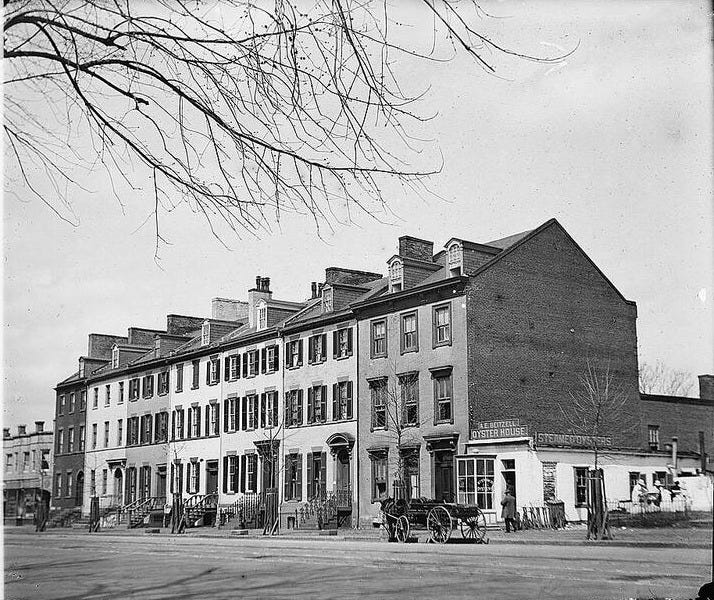
A.E. Breitzell’s Oyster House opened on the side of the buildings at 2105 Pennsylvania Avenue sometime in the later part of the 19th century. At some point in the early 1900s Albert Breitzell left the seafood business completely for the liquor trade.
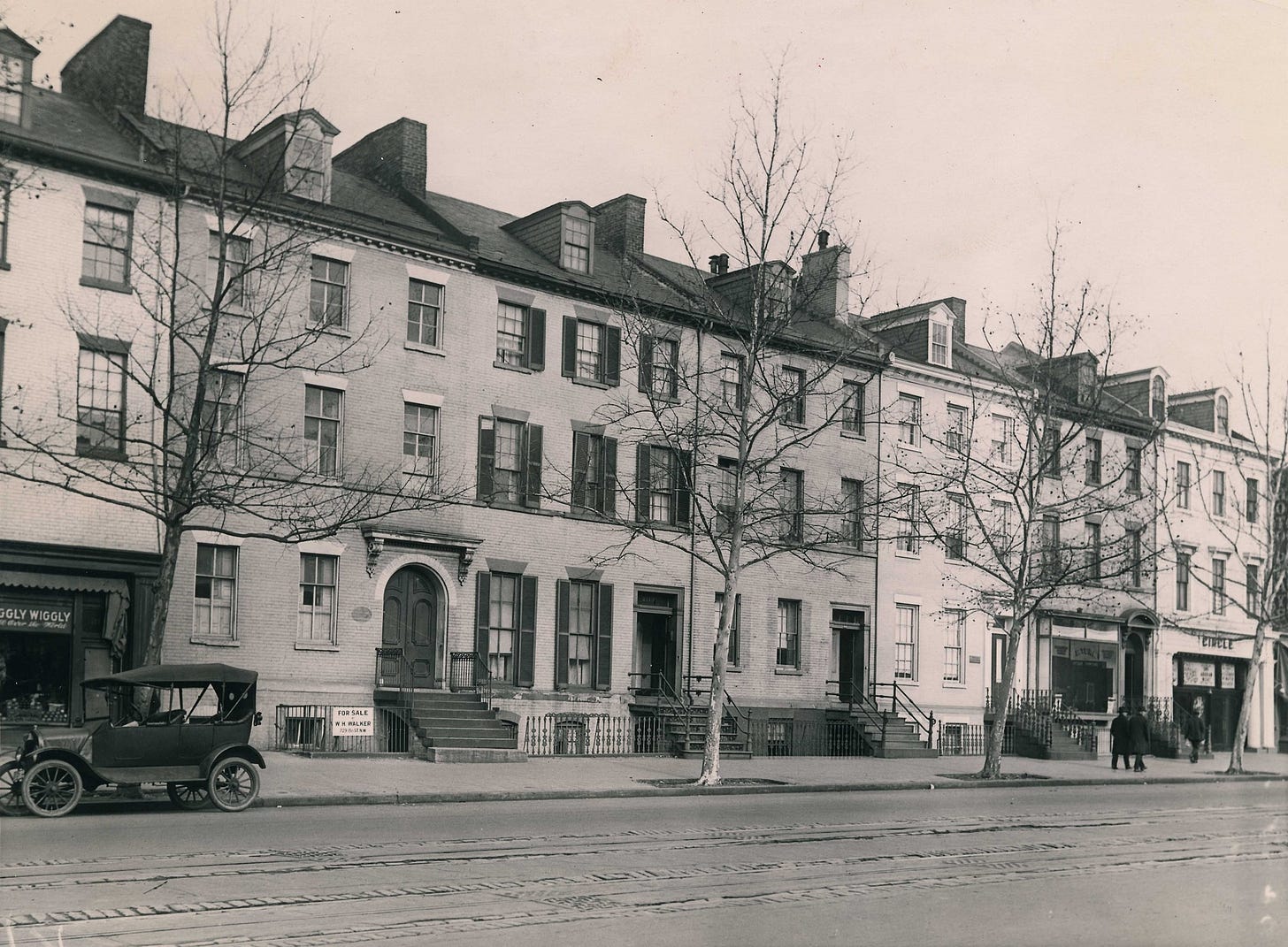
The Circle Theatre, a landmark city institution, first opened in 1910 in the end building at 2105 Pennsylvania Avenue. In 1935, it was enlarged into the neighboring lot at 2107 Pennsylvania Avenue (once occupied by the Navy Department and Sam Houston) to create an Art Deco style theater designed by the architectural firm of Albert B. Mullett & Co. The theater was enlarged again in 1968 into the neighboring lot to the west, razing a building that had earlier replaced one of the original Six Buildings that had once stood there.
In 1929, three of the Six Buildings located at 2111-2115 Pennsylvania Avenue were razed for the construction of the Marquette Apartments, which took the address of 2115 Pennsylvania Avenue.
By the mid 1980s the site of the original Six Buildings consisted of Gillies 21 Liquor Store, the Circle Theatre, the Marquette Apartments, the Group Health Association Building that occupied several lots, which included Isaac Polock’s end house at 2117 Pennsylvania Avenue, and the last of the Six Buildings at 2109 Pennsylvania Avenue, then home to a bar called Tammany Hall that was demolished in 1985, marking the end of the Six Buildings.
The Circle Theatre closed in September 1986 and was demolished with plans to erect a new 5-screen theater that was planned to open in December 1988. The new theater was never built and the site became a parking lot. At the time it was razed, the Circle Theatre had been Washington's oldest continuously operating movie theater.
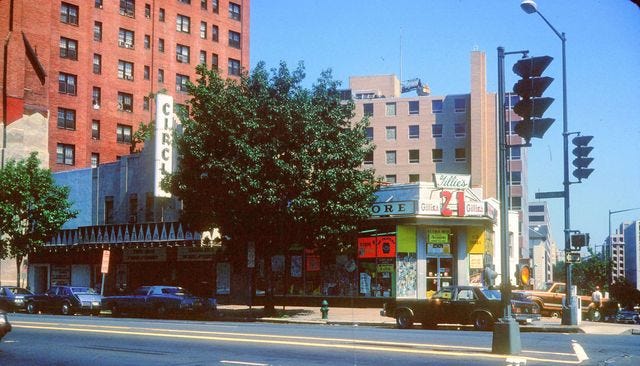
In 1997, construction began on the World Bank’s International Finance Corporation building that now occupies the entire square.




